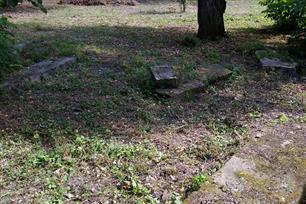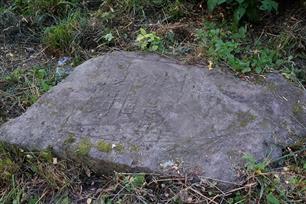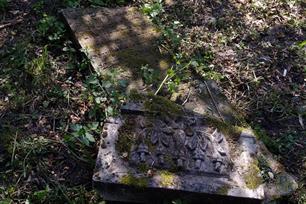Vuzlove (Cholojow)
Chervonohrad district, Lviv region
Year - Total Population - Jews
1717 - ? - 100
1880 - 3,529 - 795
1900 - 3,965 - 1,139
1921 - 4,151 - 793
1717 - ? - 100
1880 - 3,529 - 795
1900 - 3,965 - 1,139
1921 - 4,151 - 793
Sources:
- Pinkas Hakehillot Polin: Encyclopedia of Jewish Communities, Poland, Volume II, page 227-228, published by Yad Vashem, Jerusalem. Translated by Angela Brice, JewishGen, Inc.
Photo:
- European Jewish Cemeteries Initiative. Vuzlove Jewish Cemetery
- Pinkas Hakehillot Polin: Encyclopedia of Jewish Communities, Poland, Volume II, page 227-228, published by Yad Vashem, Jerusalem. Translated by Angela Brice, JewishGen, Inc.
Photo:
- European Jewish Cemeteries Initiative. Vuzlove Jewish Cemetery
Vuzlove (ukr. Вузлове), until 1946 - Cholojow (ukr. Холоїв).
It is not known exactly when the village changed from being in the hands of the aristocracy to becoming a municipal settlement. This was no doubt an on-going process, beginning at the end of the 18th century, with the selling-off of estates, which continued until the end of the 19th century. At this time, Cholojow was renowned far and wide for smuggling across the border, and the stealing of horses. Until the 1860's there was a factory at the edge of the town, which produced approx. 50,000 litres per year of (wines and spirits?), after this time the factory was closed down.
At the time of the First World War, the area changed from hand to hand. At the time of the Russian conquest, many houses were destroyed by the Cossacks. In 1915 and 1916 a plague of cholera and typhus broke out, and many of the citizens were killed.
Some Jewish families were to be found in Cholojow as early as the beginning of the 18th century. In 1717 they were obliged to pay 200 pieces of gold as a 'head tax'. The Jewish population grew during the 19th century.
Local people reported an incident, which occurred in 1913, on Kol Nidre night, in which 13, or some say 15 women lost their lives. The event was sparked off when a girl came to the ladies' gallery to warn her mother that someone had come to steal the pile of wood used for heating the oven. When they heard the word "burning", the women rushed to the door and many women were crushed to death and wounded.
During the First World War, the Jews here suffered abuse at the hands of the Cossacks and the local bet midrash was turned into a stable. When the Jews were released from the Austrian army, it was cleaned up and turned into a temporary field hospital.
In the plague which broke out after the Russian withdrawal, many Jews died. Not many came back after the war, many died from plague or fell during the war as army conscripts. Those left mostly moved to other settlements or overseas.
The first of the Jews in Cholojow were employed mainly as traders or taverners. In the 19th and 20th centuries, many of them supported themselves by small-scale businesses or peddling and a few were tradesmen.
With the establishment of the premises of the Admo”r sect in the House of Efrati in Cholojow, at the end of the 1930's, some also found employment in offering services to the Chassidim who came to visit on Shabbatot and festivals.
Between the two world wars, in the 1930's, the citizens were helped by means of a burial fund (founded in 1928), which paid for 85 burials between 1933 and 1934 at a cost of 7,196 zlotys. There was no synagogue in the town, only a bet midrash, and a small shtiebel for prayer next to it, for the ordinary folk. The cemetery was apparently dedicated at the end of the 18th century, or early in the 19th century. People of the area pointed out an ancient grave where, according to tradition, a Rabbi from Krakow was buried, who died when passing through the town.
At the beginning of the 19th century, Rabbi Ezriel bar Shimshon Grin served as Rabbi, pupil of the Seer of Lublin and Rabbi Mivlaz. He moved from Cholojow to Musti Vilkiya. After him the Rabbi of Cholojow encountered Rabbi Yehoshua Herschl bar Ya'akov Efrati, Head of "Nahalat Yehoshua", also a pupil of the Seer of Lublin and of Rabbi Avraham Yehoshua Herschl from Afta.
Rabbi Yehoshua Herschl Efrati attributed to him healing powers and miracles, his descendants followed in his path. After his death in 1852 his oldest son, Rabbi Reuven David continued until his death in 1903. He was succeeded by his son, Rabbi Mordechai, who moved to Lvov at the outbreak of the First World War, and died there in 1930.
His son, Rabbi Yekutiel took his place in Cholojow, he also died in Lvov in 1933. His son, Rabbi Shimon also served in Cholojow, during his father's lifetime, moving to Herovishow in 1933.
The Chassidim had an influence on the local community and on local elections. In elections held in 1813, the Ukrainians wanted to reduce the number of Jewish candidates, seven in the first elections, increasing to ten, which was a compromise, involving the intervention of the authorities.
Zionism didn't really get going in Cholojow until after the First World War; groups were founded in 1923, 1925 and 1930. After this it grew rapidly and Cholojow was well represented in elections for the Zionist Congress in 1935, with votes as follows: 78 General Zionists; 2 Mizrachi; 86 Workers' and 62 Radical Zionists.
In 1923-24 a course was set up on the subject of "The Organization of Jewish Education in the People's Schools and High Schools in Lvov" and in 1933 the first wholly Jewish school was established. In the same year it was decided to establish a community centre, but this wasn't in fact realised until the outbreak of World War II.
It is not known exactly when the village changed from being in the hands of the aristocracy to becoming a municipal settlement. This was no doubt an on-going process, beginning at the end of the 18th century, with the selling-off of estates, which continued until the end of the 19th century. At this time, Cholojow was renowned far and wide for smuggling across the border, and the stealing of horses. Until the 1860's there was a factory at the edge of the town, which produced approx. 50,000 litres per year of (wines and spirits?), after this time the factory was closed down.
At the time of the First World War, the area changed from hand to hand. At the time of the Russian conquest, many houses were destroyed by the Cossacks. In 1915 and 1916 a plague of cholera and typhus broke out, and many of the citizens were killed.
Some Jewish families were to be found in Cholojow as early as the beginning of the 18th century. In 1717 they were obliged to pay 200 pieces of gold as a 'head tax'. The Jewish population grew during the 19th century.
Local people reported an incident, which occurred in 1913, on Kol Nidre night, in which 13, or some say 15 women lost their lives. The event was sparked off when a girl came to the ladies' gallery to warn her mother that someone had come to steal the pile of wood used for heating the oven. When they heard the word "burning", the women rushed to the door and many women were crushed to death and wounded.
During the First World War, the Jews here suffered abuse at the hands of the Cossacks and the local bet midrash was turned into a stable. When the Jews were released from the Austrian army, it was cleaned up and turned into a temporary field hospital.
In the plague which broke out after the Russian withdrawal, many Jews died. Not many came back after the war, many died from plague or fell during the war as army conscripts. Those left mostly moved to other settlements or overseas.
The first of the Jews in Cholojow were employed mainly as traders or taverners. In the 19th and 20th centuries, many of them supported themselves by small-scale businesses or peddling and a few were tradesmen.
With the establishment of the premises of the Admo”r sect in the House of Efrati in Cholojow, at the end of the 1930's, some also found employment in offering services to the Chassidim who came to visit on Shabbatot and festivals.
Between the two world wars, in the 1930's, the citizens were helped by means of a burial fund (founded in 1928), which paid for 85 burials between 1933 and 1934 at a cost of 7,196 zlotys. There was no synagogue in the town, only a bet midrash, and a small shtiebel for prayer next to it, for the ordinary folk. The cemetery was apparently dedicated at the end of the 18th century, or early in the 19th century. People of the area pointed out an ancient grave where, according to tradition, a Rabbi from Krakow was buried, who died when passing through the town.
At the beginning of the 19th century, Rabbi Ezriel bar Shimshon Grin served as Rabbi, pupil of the Seer of Lublin and Rabbi Mivlaz. He moved from Cholojow to Musti Vilkiya. After him the Rabbi of Cholojow encountered Rabbi Yehoshua Herschl bar Ya'akov Efrati, Head of "Nahalat Yehoshua", also a pupil of the Seer of Lublin and of Rabbi Avraham Yehoshua Herschl from Afta.
Rabbi Yehoshua Herschl Efrati attributed to him healing powers and miracles, his descendants followed in his path. After his death in 1852 his oldest son, Rabbi Reuven David continued until his death in 1903. He was succeeded by his son, Rabbi Mordechai, who moved to Lvov at the outbreak of the First World War, and died there in 1930.
His son, Rabbi Yekutiel took his place in Cholojow, he also died in Lvov in 1933. His son, Rabbi Shimon also served in Cholojow, during his father's lifetime, moving to Herovishow in 1933.
The Chassidim had an influence on the local community and on local elections. In elections held in 1813, the Ukrainians wanted to reduce the number of Jewish candidates, seven in the first elections, increasing to ten, which was a compromise, involving the intervention of the authorities.
Zionism didn't really get going in Cholojow until after the First World War; groups were founded in 1923, 1925 and 1930. After this it grew rapidly and Cholojow was well represented in elections for the Zionist Congress in 1935, with votes as follows: 78 General Zionists; 2 Mizrachi; 86 Workers' and 62 Radical Zionists.
In 1923-24 a course was set up on the subject of "The Organization of Jewish Education in the People's Schools and High Schools in Lvov" and in 1933 the first wholly Jewish school was established. In the same year it was decided to establish a community centre, but this wasn't in fact realised until the outbreak of World War II.
At the time of Soviet rule in the town (Sept 1939 – June 1941), the Jews were not bothered much. However, their foundations were closed and all political activities suspended and private businesses were forbidden. With this, they did everything they could to find work such as manual work and clerking, and the youth were given the opportunity to learn in the Gymnasium which was founded at this time. Only wealthy Jews were at risk of being sent to Russia.
When the Russo-German War broke out, some Jews returned on the heels of the retreating Russians. The town suffered from battles and firing from the air. About half of the population fled to the nearby town of Radekhov.
After the German conquest on 24.6.1941 the people were taken to work-camps to carry out tasks for the Germans and the Ukrainians. A few were permitted to work on private farms in the area, to help with food production. A Judenrat was supposedly set up and functioned, although we lack definite proof of this; we do know, however that a public kitchen was set up for the poor, the elderly and the sick.
At dawn, on 15.9.1942, two days after Rosh HaShana, German and Ukrainian police descended on the town. They turned the Jews out of their homes and herded them into the market square. They fired on those who tried to escape. The rest were taken to a mass grave on the edge of the town and were shot. Only a small handful managed to escape the "Aktion", a few had hidden earlier or on the way, and some were at work. Six weeks later came the final "Aktion", it is not known if they perished in the forest or they were taken to Belzec Extermination Camp.
A handful of Jews are believed to have survived this too, but their fate is unknown. These two "Aktions" also involved a number of Jews from the area, who had previously been rounded up.
When the Russo-German War broke out, some Jews returned on the heels of the retreating Russians. The town suffered from battles and firing from the air. About half of the population fled to the nearby town of Radekhov.
After the German conquest on 24.6.1941 the people were taken to work-camps to carry out tasks for the Germans and the Ukrainians. A few were permitted to work on private farms in the area, to help with food production. A Judenrat was supposedly set up and functioned, although we lack definite proof of this; we do know, however that a public kitchen was set up for the poor, the elderly and the sick.
At dawn, on 15.9.1942, two days after Rosh HaShana, German and Ukrainian police descended on the town. They turned the Jews out of their homes and herded them into the market square. They fired on those who tried to escape. The rest were taken to a mass grave on the edge of the town and were shot. Only a small handful managed to escape the "Aktion", a few had hidden earlier or on the way, and some were at work. Six weeks later came the final "Aktion", it is not known if they perished in the forest or they were taken to Belzec Extermination Camp.
A handful of Jews are believed to have survived this too, but their fate is unknown. These two "Aktions" also involved a number of Jews from the area, who had previously been rounded up.

- Home
- Shtetls
- Vinnytsia region
- Volyn region
- Dnipro region
- Donetsk region
- Zhytomyr region
- Zakarpattia region
- Zaporizhzhia region
- Ivano-Frankivsk region
- Kyiv region
- Kropyvnytskyi region
- Luhansk region
- Lviv region
- Mykolayiv region
- Odessa region
- Poltava region
- Rivne region
- Sumy region
- Ternopil region
- Kharkiv region
- Kherson region
- Khmelnytskyi region
- Chernihiv region
- Chernivtsi region
- Cherkasy region
- Crimea
- Synagogues
- Cemeteries
- Objects & guides
- Old photos
- History
- Contact
Jewish towns of Ukraine
Jewish towns of Ukraine
My shtetl
My shtetl
Donate


